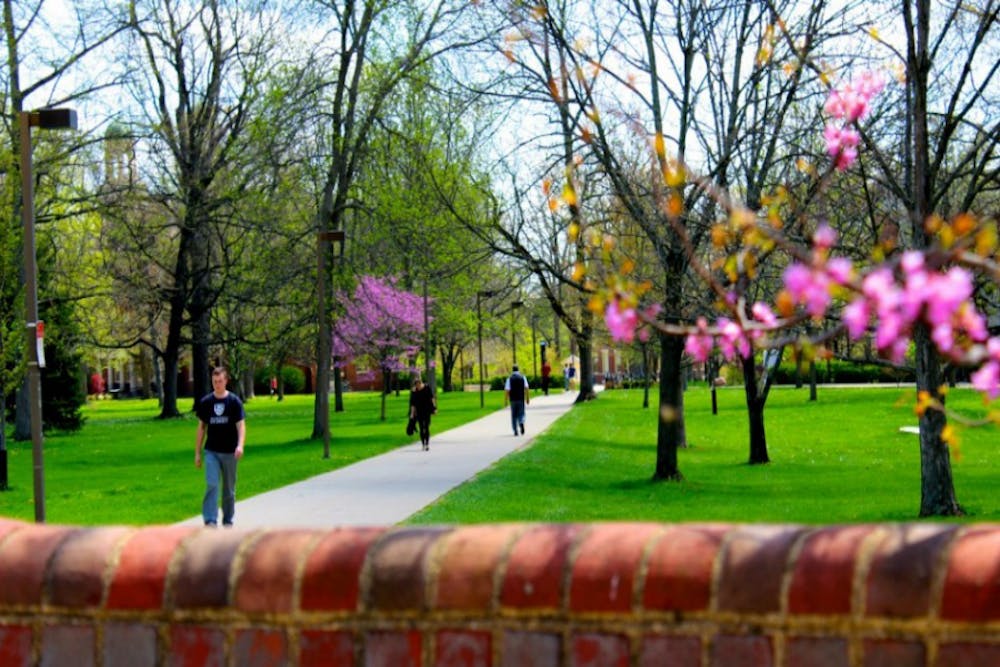Angie Riffle, For The Miami Student
For students living in the new Western dorms fall semester, air conditioning and heating will not be fueled by Miami University's traditional coal-powered methods. Instead, Miami has taken a step toward eliminating coal as a power source by building a geothermal power plant on Western Campus.
The $9 million geothermal power plant and well field provide hot and cold water to three new dorms and a new dining hall on Western Campus through 72 miles of underground piping.
According to Doug Hammerle, the director of energy systems at Miami, the geothermal system is expected to be 442 percent more efficient than the old system of steam boilers and cooling towers. Miami's utility master plan calls for 40 percent of campus, including all of Western Drive, to be converted to geothermal energy by 2025. Simultaneous heating and cooling will be included in renovations for buildings in the remaining 60 percent, beginning with the construction of East Quad buildings.
By 2025, Miami plans to completely eliminate coal as a fuel source.
"It's about developing a long-term strategy that makes both financial sense and environmental sense," said Thomas Crist, the director of Miami's Institute for the Environment and Sustainability.
The geothermal energy project cost the university a total of $23 million, which is $10 million more than updating the current system. This new system of energy production, however, will save up to $1.5 million a year in utilities and maintenance.
"We've got two of every pump in the basement, so that if one breaks down it's still operational," said Larry Davidson, the geothermal energy plant manager. "You're probably talking 15 years before you have to do any overhaul on anything."
A photo timeline on Davidson's office wall shows different stages in the plant's construction. Original construction for the geothermal project began in July 2012 and was officially completed in February 2014. Connections to the dorms were put up in early April.
In order to provide heated water in the winter and cold water in the summer, the geothermal wells use the steady 55-degree temperature of the earth to heat cold water and cool hot water.
"The great thing about Ohio is that we have seasons," Hammerle said.
Additionally, the plant uses a closed-loop system, which circulates water through the buildings and wells without losing any water in the process. This will save around 7 million gallons of water annually.
Enjoy what you're reading?
Signup for our newsletter
"The only time we need water is when we are putting new buildings on the line," Davidson said.
The geothermal power plant, located behind the new Western buildings and Havighurst Hall, will not only provide year-round heating and cooling, but also serve as an educational outlet. A small deck on the second floor of the plant includes a section of the same material used on the building's green roof for students to observe and interact with.
Additionally, the vibrant colors of the plant's piping are not just for show.
"The pipes are actually color-coded for educational purposes," Davidson said.
Each pipe is colored according to the temperature of the water that flows through it so students can see how the water is transferred between the ground, pumps and chillers. Davidson has already begun giving tours of the plant to architecture and engineering students, and expects more students to come in the future.
"I've had about four or five-hundred students come through so far," said Davidson, who was expecting 27 engineering students to tour the plant later that day.
"It's super cool that they're using geothermal energy," said Alana Carson, a sophomore interior design major living in one of the new western dorms.
"It's interesting that Miami's looking into new technology. I definitely think we could benefit from using the plant as a learning tool." Cody Powell, the associate vice president of facilities planning and operations at Miami University, said that Miami is a leader for energy efficiency in Ohio's higher education.
Miami's sustainability is appraised using the LEED, or Leadership in Energy and Environmental Design, system. LEED ranks building projects based on their efficiency and environmental impact.
According to Powell, Miami has successfully achieved LEED silver, the third-highest ranking, in all of its new building renovations so far, and will continue to strive for improvement in its sustainability in the future.




